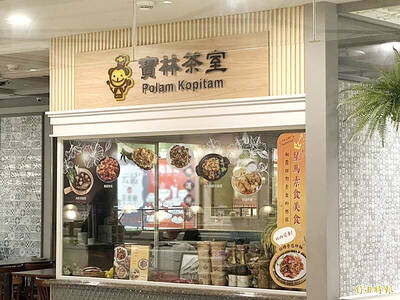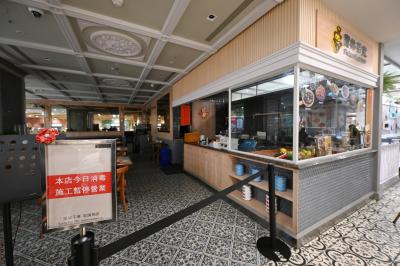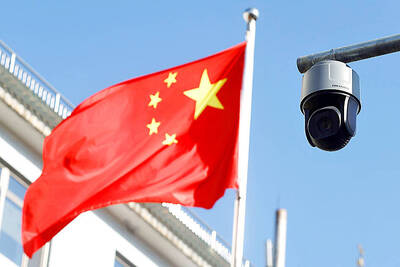The illumination of the world's largest public glass art work -- the Dome of Light -- at Kaohsiung Rapid Transit System's Formosa Boulevard Station yesterday marked the official beginning of the city's era of transformation.
During the opening ceremony held under the dome yesterday, Kaohsiung Rapid Transit Corp (KRTC) chairman Lin Wen-yuan (
The launch was confirmed after the company obtained its permit of operation from the Ministry of Transportation and Communications (MOTC) yesterday morning, Lin said.
During an inspection of the Red Line on Tuesday, MOTC inspectors gave the company a conditional green light of operation, demanding the company correct five flaws, including running tests of all ticketing machines and obtaining official documents proving the safety of the system's firefighting equipment.
Free rides will be granted to passengers for a period of one month through the end of the Tombsweeping holiday early next month, Lin said yesterday.
The new service is expected to bring major changes to the lifestyle of Kaohsiung residents as this is the city's first rapid transit route.
Yesterday's ceremony was held at the Formosa Boulevard Station, which is near the site of the Kaohsiung Incident.
The Kaohsiung Incident, also known as the Formosa Incident, took place on Dec. 10, 1979, when the Chinese Nationalist Party (KMT) government cracked down and imprisoned participants in an anti-government parade organized by Formosa magazine.
President Chen Shui-bian (陳水扁), who attended the ceremony, said the illumination of the dome is particularly meaningful to Taiwanese people, who have been pursuing freedom and democracy.
The 660m2 dome, created by Italian maestro Narcissus Quagliata, embodies the incident in the art work, the KRTC said.
The work displays the spirit of "tolerance" through the incorporation of the elements "water," "earth," "light" and "fire" into the art piece, the KRTC said.
"I was aware that here in this square a very important incident happened," Quagliata said. "I felt it was a responsible and interesting thing to relink and include that in our project so that people will remember the incident."
The dome, which is composed of four major quadrants, also explores themes related to reincarnation such as "birth, growth, honor, destruction and rebirth," the KRTC said.
"Transportation and transformation are linked," Quagliata said.
"When a city decides to change, the first thing it changes is the way people move," Quagliata told the Taipei Times.
"When that happens, the city transforms itself, and there is an opportunity for many things to happen, in art, business, lifestyle and many departments," he said.

POLAM KOPITIAM CASE: Of the two people still in hospital, one has undergone a liver transplant and is improving, while the other is being evaluated for a liver transplant A fourth person has died from bongkrek acid poisoning linked to the Polam Kopitiam (寶林茶室) restaurant in Taipei’s Far Eastern Sogo Xinyi A13 Department Store, the Ministry of Health and Welfare said yesterday, as two other people remain seriously ill in hospital. The first death was reported on March 24. The man had been 39 years old and had eaten at the restaurant on March 22. As more cases of suspected food poisoning involving people who had eaten at the restaurant were reported by hospitals on March 26, the ministry and the Taipei Department of Health launched an investigation. The Food and

A fourth person has died in a food poisoning outbreak linked to the Xinyi (信義) branch of Malaysian restaurant chain Polam Kopitiam (寶林茶室) in Taipei, Deputy Minister of Health and Welfare Victor Wang (王必勝) said on Monday. It was the second fatality in three days, after another was announced on Saturday. The 40-year-old woman experienced multiple organ failure in the early hours on Monday, and the family decided not to undergo emergency resuscitation, Wang said. She initially showed signs of improvement after seeking medical treatment for nausea, vomiting and diarrhea, but her condition worsened due to an infection, he said. Two others who

The long-awaited Taichung aquarium is expected to open next year after more than a decade of development. The building in Cingshui District (清水) is to feature a large ocean aquarium on the first floor, coral display area on the second floor, a jellyfish tank and Dajia River (大甲溪) basin display on the third, a river estuary display and restaurant on the fourth, and a cafe and garden on the fifth. As it is near Wuci Fishing Port (梧棲漁港), many are expecting the opening of the aquarium to bring more tourism to the harbor. Speaking at the city council on Monday, Taichung City Councilor

Taiwanese should be mindful when visiting China, as Beijing in July is likely to tighten the implementation of policies on national security following the introduction of two regulations, a researcher said on Saturday. China on Friday unveiled the regulations governing the law enforcement and judicial activities of national security agencies. They would help crack down on “illegal” and “criminal” activities that Beijing considers to be endangering national security, according to reports by China’s state media. The definition of what constitutes a national security threat in China is vague, Taiwan Thinktank researcher Wu Se-chih (吳瑟致) said. The two procedural regulations are to provide Chinese